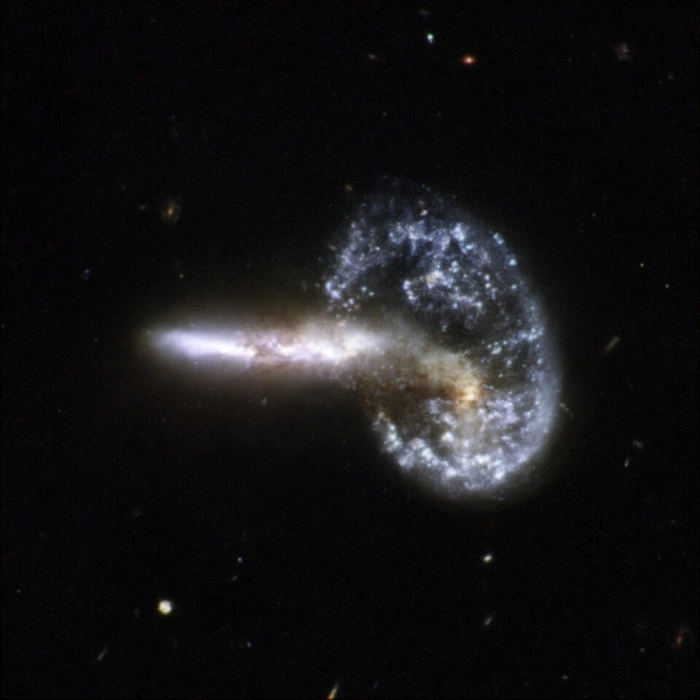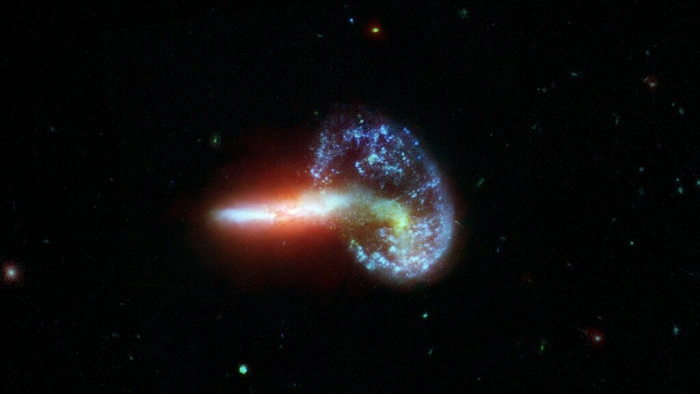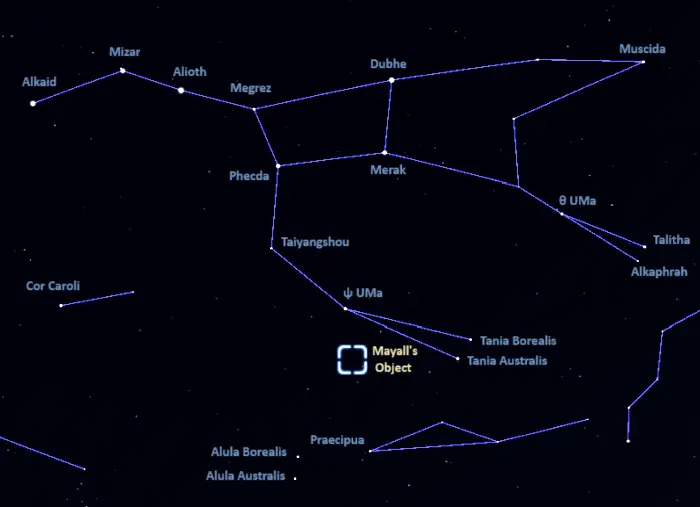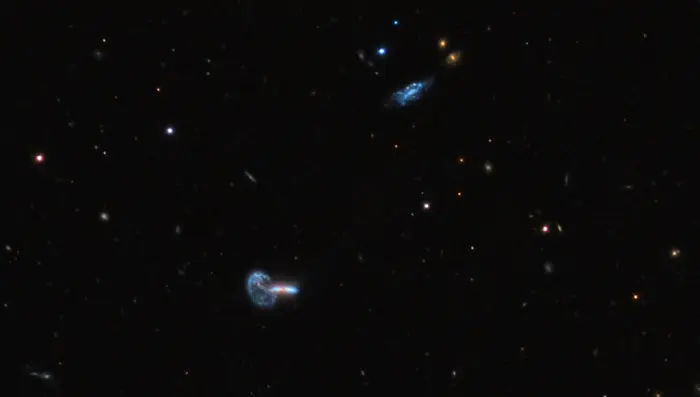Mayall’s Object is the product of a collision of two galaxies located approximately 450 million light years away in the constellation of Ursa Major (the Great Bear). The galactic pair is about 80,000 light-years across.
Once believed to be a galaxy interacting with the intergalactic medium, Mayall’s Object is now known to be the product of a merger of two galaxies, appearing as a ring-shaped galaxy with a tail. Astronomers believe that the collision of the parent galaxies created a shockwave that initially drew stars and interstellar matter to the centre and then made the material propagate outwards to create a ring. The shockwave was created when one of the colliding galaxies pierced the other. As a result, the structure of both galaxies has dramatically changed.
The elongated companion that appears perpendicular to the ring is what is left of the galaxy that did the piercing. The dust and gas in the other galaxy have been pushed outward to form a ring galaxy. The galactic encounter has triggered star formation in both galaxies.

Arp 148 is the staggering aftermath of an encounter between two galaxies, resulting in a ring-shaped galaxy and a long-tailed companion. The collision between the two parent galaxies produced a shockwave effect that first drew matter into the center and then caused it to propagate outwards in a ring. The elongated companion perpendicular to the ring suggests that Arp 148 is a unique snapshot of an ongoing collision. Infrared observations reveal a strong obscuration region that appears as a dark dust lane across the nucleus in optical light. This image is part of a large collection of 59 images of merging galaxies taken by the Hubble Space Telescope and released on the occasion of its 18th anniversary on 24th April 2008. Image credit: NASA, ESA, the Hubble Heritage (STScI/AURA)-ESA/Hubble Collaboration, and A. Evans (University of Virginia, Charlottesville/NRAO/Stony Brook University) (PD)
Mayall’s Object represents a phase in an ongoing galactic collision. The dark dust lane that obscures the nucleus in optical images appears as an obscuration region at infrared wavelengths.
Mayall’s Object is one of the best-known collisional ring galaxies in the sky, along with the Cartwheel Galaxy (LEDA 2248) in the constellation Sculptor, Arp 147 in Cetus, and the Bullseye Galaxy (LEDA 1313424) in Pisces. These galaxies are believed to form when a smaller galaxy passes through the centre of a larger neighbour. The gravitational disruptions caused by the collision send a wave of star formation throughout the galaxies.
Facts
Mayall’s Object was named after the American astronomer Nicholas U. Mayall, who discovered it on March 13, 1940. Mayall spotted the colliding galaxies in a photograph taken using the Crossley reflector at the Lick Observatory on Mount Hamilton, California. The object was initially described as a “peculiar nebula.” Mayall first noticed it on a negative because of the object’s peculiar appearance, similar to that of a question mark. He was unable to determine whether the object was galactic or extragalactic in nature.
American astronomer Halton Arp included Mayall’s Object in his Atlas of Peculiar Galaxies of 1966 as object number 148.
Mayall’s Object was imaged by the Wide Field and Planetary Camera 2 aboard the Hubble Space Telescope (HST) in 2008. The image was released for Hubble’s 18th anniversary as part of a large collection of images of colliding galaxies.

This image shows galaxy Arp 148, captured by NASA’s Spitzer and Hubble telescopes. Also known as Mayall’s Object, Arp 148 captures a point in the interaction of two galaxies in which a ring has formed in the wake of their collision. The thick clouds of dusty material in the elongated galaxy (left) glow brightly in the infrared wavelengths of light seen by Spitzer (8 microns, red), while the glow of starlight dominates the visible light data from Hubble (0.3-0.8 microns, blue-green). Credit: Spitzer / Hubble space telescopes with NASA, JPL / ESA (CC BY 2.5)
Location
Mayall’s Object lies in the southern part of Ursa Major, in the region of the Great Bear’s feet. It can be found about a third of the way from Psi Ursae Majoris to Praecipua, the brightest star in the faint constellation Leo Minor. It appears around 3.8 degrees south-southwest of Psi UMa.
The orange giant Psi UMa lies along the imaginary line extended from Megrez through Phecda in the Big Dipper. Praecipua can be found using the Three Leaps of the Gazelle, an asterism composed of three pairs of stars that mark the Great Bear’s feet. It is the brightest star between Alula Borealis and Alula Australis, the First Leap, and Tania Borealis and Tania Australis, the Second Leap.

Location of Mayall’s Object, image: Stellarium
With an apparent magnitude of 15.4 and an apparent size of 0.43 by 0.172 arcminutes, Mayall’s Object is best observed in large telescopes at high magnification. The piercing galaxy can be spotted in 16-inch telescopes, but the fainter ring requires larger instruments and exceptionally good conditions.
Mayall’s Object – PGC 33423
| Constellation | Ursa Major |
| Object type | Colliding galaxies |
| Right ascension | 11h 03m 53.89153s |
| Declination | +40° 50′ 59.8850″ |
| Apparent magnitude | 15.4 |
| Apparent size | 0.430’ x 0.172’ |
| Distance | 450 million light-years (140 megaparsecs) |
| Redshift | 0.034524 |
| Heliocentric radial velocity | 10171 km/s |
| Names and designations | Mayall’s Object, PGC 33423, LEDA 33423, VV 032, VV 32, Arp 148, APG 148, MCG +07-23-019, IRAS 11010+4107, IRAS F11011+4107, 2MASX J11035389+4050598, TGSSADR J110353.8+405100, CASG 1358, FIRST J110353.9+405059, GB6 B1101+4107, WN B1101.0+4107, EQ 1101+411, KUG 1101+411, PSCz Q11010+4107, NVSS J110353+405059 |

Mayall’s Object, image credit: Adam Block/Mount Lemmon SkyCenter/University of Arizona (CC BY-SA 4.0)